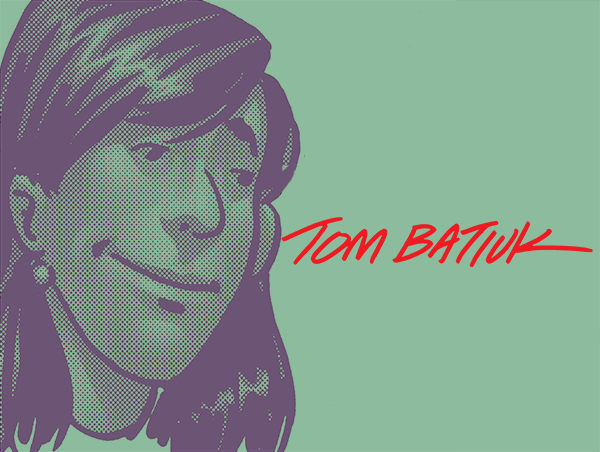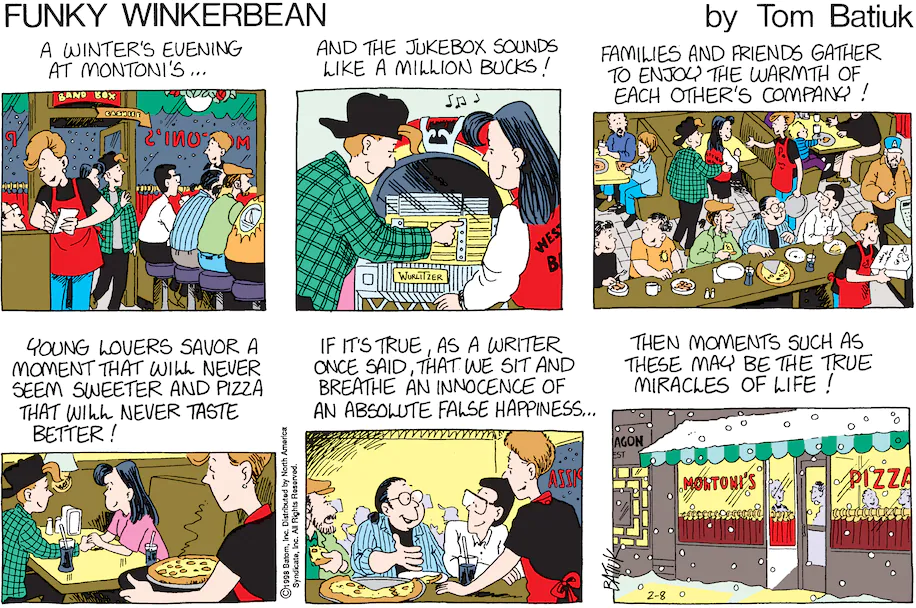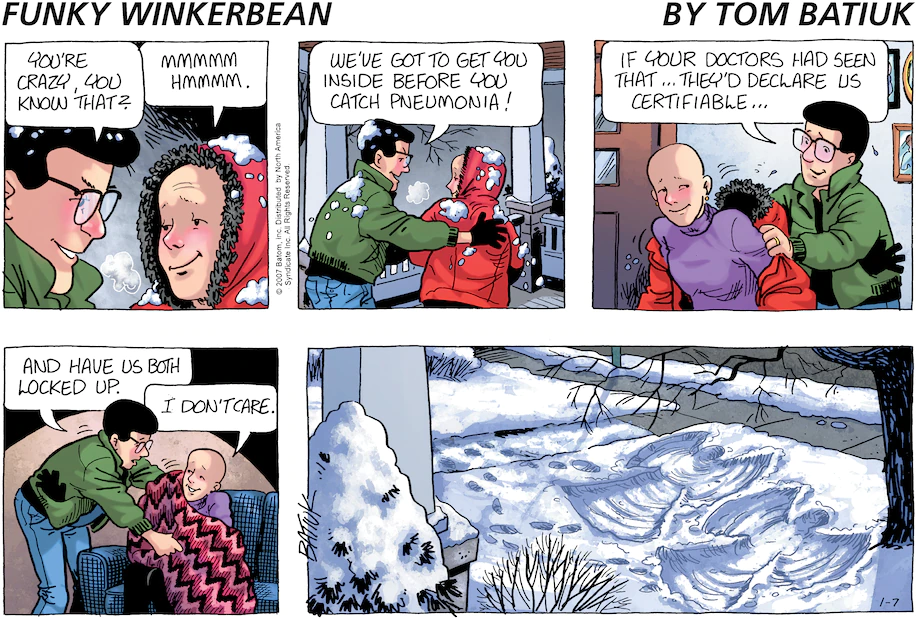×

Subscribe to Receive the Latest Updates
Subscribe to receive our monthly newsletter.
Article posted on August 22, 2022 Washington Post

Tom Batiuk, here pictured in his home studio in Medina, Ohio, in 2012, is celebrating the 50th anniversary of his comic strip “Funky Winkerbean” with a reunion arc this week. (Amy Sancetta/AP)
Tom Batiuk was 25 when he cracked the comics page and was billed as a voice for his generation. Today, at 75, the Ohio-based cartoonist is still staying true to that mission.
“I started out writing about kids in high school who worry about trying to get a date and climbing the rope in gym class,” says the “Funky Winkerbean” creator this month by Zoom from Medina, Ohio. “Now, I’m writing about going to financial seminars and getting colonoscopies and playing pickleball.”
He grins with understatement: “It’s a whole different world.”
Batiuk believes his longtime readers have gained life wisdom just as his characters have — through the long arc of experience and perspective. And starting Monday, “Funky Winkerbean” will celebrate its 50th anniversary with a storyline in which a gray-haired reunion of the title character and his peers at Westview High leads to senior discoveries.
“I’m looking at the flip side of reunions,” Batiuk says of exploring the honesty beneath such a gathering’s initial artifice, as former classmates realize they all felt “clueless” while in high school.

To celebrate the 50th anniversary of “Funky Winkerbean,” the strip’s title character attends a golden high school reunion in a story arc beginning Monday. (Tom Batiuk/KFS)
The reunion arc spotlights aging characters who have weathered so much in “Funky’s” half-century, from enduring love to profound loss — a golden milestone not often achieved by a single syndicated creator. And no modern mainstream comic strip this side of “Doonesbury” has so often dealt with the challenges of mental and physical health, and so sensitively handled the death of a beloved cast member.
Suicide. Abuse. PTSD. CTE. And most poignantly, cancer. Given such subject matter, pain and mortality often lurk in “Funky Winkerbean.”
Batiuk proudly owns this creative space, balancing cheekiness and the bleakness. He smiles at “Funky’s” serious themes being satirized on the humor site the Comics Curmudgeon, and laughs when recalling that one reader emailed to accuse him: “You’re ruining comics for everyone.”
“I was never writing a strip not to get any complaints,” Batiuk says. “I’m on this railroad that circles the other comic strips — I’m out there by myself. Nobody bothers me, and I can do what I want.” That includes treating themes of import with optimism, including LGTBQ acceptance at a prom. Now, “Nobody bats an eye.”
Batiuk also notes that in talks with King Features, he negotiated for editorial control over “Funky,” which his syndicate says is distributed to about 400 newspapers. (The Washington Post doesn’t carry the strip.)
“One of the things Tom does beautifully is, he’s really able to tell serialized stories that are real and serious stories, and balance that really well with humor,” says Tea Fougner, editorial director for comics at King.
She thinks that both “Funky Winkerbean” and “Crankshaft” — the spinoff strip that Batiuk created with Chuck Ayers — “feel like sitcoms that are dealing with real issues that matter to people.”
That’s a long way from where “Funky” began.

Batiuk feels free to tackle any serious subject. (Amy Sancetta/AP)
Batiuk was born in Akron and grew up in Ohio, that famed cradle of cartoonists, from the pioneering 19th-century “Yellow Kid” writer-artist Richard Outcault to such modern greats as Bill Watterson of “Calvin and Hobbes.” The “Funky” creator graduated from Kent State — the year before the Vietnam War-era shootings on campus there — and by the early 1970s was teaching middle school graphic arts and pursuing an art career himself.
After drawing newspaper panel cartoons aimed at a teenage audience for his hometown Elyria Chronicle Telegram, Batiuk headed to New York to visit the syndicates. Editors had an appetite for fresh features depicting youth culture — a far cry, he recalls, from the malt shops and letterman sweaters in older comics.

The world of “Funky Winkerbean” has matured along with its creator, Tom Batiuk. This 1998 strip highlights a midpoint in the comic’s 50-year evolution. ( Tom Batiuk/KFS)
During Batiuk’s first stop, an editor handed him a book of his syndicate’s recently launched “Doonesbury” to peruse. A subsequent stop, Publishers-Hall Syndicate, was “looking for something ‘Doonesbury’-like.” Batiuk got signed.
“As soon as I got hold of my strip, I was off and running,” he says. “It was never like ‘Doonesbury’ — it sort of walked some of the same territory, but I soon went different places.”
[As ‘Doonesbury’ turns 50, Garry Trudeau picks his 10 defining strips]
Batiuk built his original characters around people he knew: a roommate here, a teacher there, as well as students in classes he taught. “I changed the names just to keep from getting sued,” he says with a laugh. And centering his strip on high school life, including band geeks — he was a trombonist himself — allowed him “to deal with something that I really understood.”

Batiuk’s reality-based strip “Funky Winkerbean” launched with this strip in March of 1972, with a mission to reflect that era’s youth culture. ( Tom Batiuk/KFS)
“Funky” was a gag-a-day strip for the better part of two decades. Yet Batiuk yearned to go deeper.
Batiuk stopped teaching for a time when he launched “Funky.” A former high school art teacher of his, though, invited the cartoonist to sit in on his class occasionally — to stay in touch with how true students spoke and behaved. That environment has long sparked ideas.
At one point, Batiuk sketched a pregnant student. Weeks later, he found inspiration in that drawing. In 1986, he decided a recently introduced student character, Lisa, would carry a child — the first time a mainstream comic strip addressed teen pregnancy, according to the syndicate, which received tens of thousands of requests for reprints of that series.
“I didn’t realize at the time what that was going to do, because it changed my characters,” Batiuk says. “That little story arc allowed them to grow just enough that I wasn’t going to be able to take them back again to do the silly stuff.”

In 2001, “Funky Winkerbean” reflected on the first pregnancy of Lisa, when she was a teenager. ( Tom Batiuk/KFS)
As Batiuk deepened his characters, he eventually chose to reboot his strip. In 1992, “Funky” unveiled its first time-jump: A cast graduating from high school was suddenly sprung ahead into young adult life — an aging of the characters that’s relatively uncommon in newspaper comics, and most enduringly executed by “Gasoline Alley,” a strip Batiuk read as a child.
“When I made the first time-jump, it was amazing — it was a Road to Damascus moment” in the strip’s evolution, says Batiuk, noting that he went from “doing entertainment and escapism to doing something more grown-up and confrontational.” His strip more sharply reflected reality. He realized: “I could stop writing about cartoon characters and I could start writing about human beings.”
Batiuk steered toward longer arcs. In 1995, he tackled the subject of teen suicide. Later in the decade, Lisa and boyfriend Les got married, as did the title character and his girlfriend, Cindy. Then in 1999, Lisa received a breast cancer diagnosis; Batiuk depicted her journey, including chemotherapy and a mastectomy.
Lisa had a daughter and pursued a law career before her cancer returned in 2006. Her death a year later shook many fans. Batiuk was named a Pulitzer Prize finalist in 2008 for his portrayal of Lisa’s battle, and the collected cancer strips were published as “Lisa’s Story: The Other Shoe.”
“The cancer story almost chose me,” Batiuk says. Between the first and second parts of Lisa’s medical narrative, Batiuk himself learned he had prostate and thyroid cancer (today he is cancer-free). His own diagnosis, he says, “made me realize the difference between empathizing and personally experiencing.” He drew upon such emotions as fear. “I think that’s what deepened the work when I got to the last part of the story.”
He also heard from cancer patients while doing signings in coordination with hospitals. One woman told him she had gotten checked — her breast cancer was detected very early — because of “Lisa’s Story,” he says.

“Funky Winkerbean” depicts a poignant moment in the relationship of Les and Lisa Moore in 2007 — the year Lisa would die from breast cancer. (Tom Batiuk/KFS)
Shortly after Lisa’s death, Batiuk decided to reboot “Funky” again because he didn’t want to dwell on Les’s mourning. The strip jumped ahead a decade. “As I’ve aged these characters, my readers have been graciously aging along with us — with me and my characters,” he says. “They’re the people still reading newspapers, and that’s been a very good thing.”
Batiuk considers himself fortunate to have chronicled his comic world for this long: “I’m just following that work I established 50 years ago, where I’m sitting in that high school and sketching and seeing things happen and translating it to stories.”
And now that he is 75, is retirement on the horizon?
“Willie Nelson had the perfect answer to that. Someone asked him if he was going to retire. He goes: ‘Retire from what?’ This is what I wanted to be my whole life. This is my dream job.”